Cofactor of BRCA1 modulates androgen-dependent transcription and alternative splicing
- PMID: 17659869
- PMCID: PMC2701476
- DOI: 10.1016/j.jsbmb.2007.05.031
Cofactor of BRCA1 modulates androgen-dependent transcription and alternative splicing
Abstract
Transcriptional activity of nuclear receptors (NRs) is influenced by a large number of coregulators that exert their actions predominantly at the transcription initiation step. Unlike most well-characterized NR coregulators, cofactor of BRCA1 (COBRA1), a subunit of the negative elongation factor (NELF), binds to estrogen receptor alpha (ERalpha) and modulates estrogen-dependent transcription by impeding the movement of RNA polymerase II (RNAPII) during the transcription elongation stage. Here we show that, in addition to ERalpha, COBRA1 also displays various degrees of affinity for several other NRs. In particular, COBRA1 binds strongly to androgen receptor (AR) via its ligand-binding domain (LBD). Small hairpin RNA (shRNA)-mediated reduction of endogenous COBRA1 enhances androgen-mediated transcription. The effect of COBRA1 knockdown can be rescued by a silent mutant COBRA1 that is refractory to the shRNA action. Using a reporter assay for alternative splicing, we also provide evidence for a role of COBRA1 in influencing the exon skipping/inclusion of nascent transcripts produced from an androgen-dependent promoter. These findings suggest that COBRA1 may coordinate multiple steps in ligand-dependent gene expression, which in turn ensures both the quantity and quality of hormone-stimulated gene products.
Figures
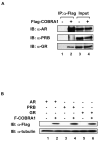
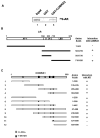
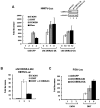

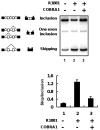
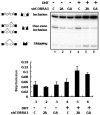
Similar articles
-
Mouse cofactor of BRCA1 (Cobra1) is required for early embryogenesis.PLoS One. 2009;4(4):e5034. doi: 10.1371/journal.pone.0005034. Epub 2009 Apr 2. PLoS One. 2009. PMID: 19340312 Free PMC article.
-
Attenuation of estrogen receptor alpha-mediated transcription through estrogen-stimulated recruitment of a negative elongation factor.Genes Dev. 2004 Sep 1;18(17):2134-46. doi: 10.1101/gad.1214104. Genes Dev. 2004. PMID: 15342491 Free PMC article.
-
Regulation of clustered gene expression by cofactor of BRCA1 (COBRA1) in breast cancer cells.Oncogene. 2007 Apr 19;26(18):2543-53. doi: 10.1038/sj.onc.1210047. Epub 2006 Oct 16. Oncogene. 2007. PMID: 17043641
-
Identification and characterization of androgen receptor associated coregulators in prostate cancer cells.J Biol Regul Homeost Agents. 2001 Apr-Jun;15(2):123-9. J Biol Regul Homeost Agents. 2001. PMID: 11501969 Review.
-
Androgen receptor corepressors: an overview.Prostate. 2005 May 1;63(2):117-30. doi: 10.1002/pros.20170. Prostate. 2005. PMID: 15486994 Review.
Cited by
-
Mouse cofactor of BRCA1 (Cobra1) is required for early embryogenesis.PLoS One. 2009;4(4):e5034. doi: 10.1371/journal.pone.0005034. Epub 2009 Apr 2. PLoS One. 2009. PMID: 19340312 Free PMC article.
-
Regulation of androgen-responsive transcription by the chromatin remodeling factor CHD8.Mol Endocrinol. 2010 Jun;24(6):1165-74. doi: 10.1210/me.2009-0421. Epub 2010 Mar 22. Mol Endocrinol. 2010. PMID: 20308527 Free PMC article.
-
DFF-ChIP: a method to detect and quantify complex interactions between RNA polymerase II, transcription factors, and chromatin.Nucleic Acids Res. 2024 Oct 14;52(18):e88. doi: 10.1093/nar/gkae760. Nucleic Acids Res. 2024. PMID: 39248105 Free PMC article.
-
Somatic alterations contributing to metastasis of a castration-resistant prostate cancer.Hum Mutat. 2013 Sep;34(9):1231-41. doi: 10.1002/humu.22346. Epub 2013 Jun 3. Hum Mutat. 2013. PMID: 23636849 Free PMC article.
-
A conserved protein motif is required for full modulatory activity of negative elongation factor subunits NELF-A and NELF-B in modifying glucocorticoid receptor-regulated gene induction properties.J Biol Chem. 2013 Nov 22;288(47):34055-34072. doi: 10.1074/jbc.M113.512426. Epub 2013 Oct 6. J Biol Chem. 2013. PMID: 24097989 Free PMC article.
References
-
- Nilsson S, Makela S, Treuter E, Tujague M, Thomsen J, Andersson G, Enmark E, Pttersson K, Warner M, Gustafsson JA. Mechanisms of estrogen action. Physiol Rev. 2001;81:1535–1565. - PubMed
-
- Glass CK, Rosenfeld MG. The coregulator exchange in transcriptional functions of nuclear receptors. Genes & Dev. 2000;14:121–141. - PubMed
-
- McKenna NJ, O'Malley BW. Combinatorial control of gene expression by nuclear receptors and coregulators. Cell. 2002;108:465–474. - PubMed
-
- Orphanides G, Reinberg D. RNA polymerase II elongation through chromatin. Nature. 2000;407:471–475. - PubMed
Publication types
MeSH terms
Substances
Grants and funding
LinkOut - more resources
Full Text Sources
Research Materials
Miscellaneous

